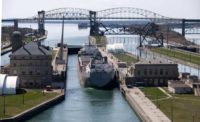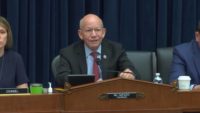Congress has approved major water infrastructure legislation that authorizes $3.7 billion for new Army Corps of Engineers civil-works projects and $4.4 billion for the Environmental Protection Agency drinking-water program.
But those authorizations still would require annual appropriations before the Corps and local water agencies can let construction contracts.
Final congressional approval for the America's Water Infrastructure Act came on Oct. 10, when the Senate passed the measure by an overwhelming 99-1 vote.
[See earlier ENR story on the legislation, with other industry officials' comments.]
The water legislation now goes to President Trump for his signature.
If enacted in coming days, it would be the second significant infrastructure bill to go on the books within about a week. A five-year Federal Aviation Administration bill, including authorizations for FAA's Airport Improvement Program construction grants, was enacted on Oct.5.
A major element of the water infrastructure legislation is a new Water Resources Development Act (WRDA) title, which authorizes $3.7 billion in federal funds for 12 Corps flood protection and other projects. Non-federal matching funds would bring the Corps projects' total to about $5.6 billion.
The new WRDA's largest single Corps allocation is $2.2 billion for flood protection and ecosystem restoration in Texas.
The WRDA title also has increased funding ceilings for three other Corps projects authorized in the past but whose costs had climbed above their authorized limits.
Approval of the water bill, including the WRDA section, continues a recent trend of passing a WRDA every two years. It follows WRDAs that became law in 2014 and 2016.
Mike Toohey, Waterways Council Inc. president and chief executive officer, said in a statement, "The passage of WRDA 2018 is a win for the nation's towboat operators, freight shipper, ports and labor and conservation groups that rely on an efficient inland waterways system."
Senate Environment and Public Works Committee Chairman John Barrasso (R-Wyo.), the lead Senate negotiator in producing the final version of the bill, said in a statement that the legislation "will cut Washington red tape, grow the nation's economy and help keep communities safe."
Still, industry officials have cautioned that the Corps projects next would have to compete for appropriations with many others authorized in past WRDAs.
The Senate committee's top Democrat, Tom Carper (Del.), noted that the Corps has estimated it has a construction-project backlog of $96 billion but its annual civil-works appropriations are only about $4.6 billion.
Besides the Corps project allotments, the water infrastructure measure authorizes $4.4 billion over three years for EPA assistance to state revolving loan funds for drinking-water projects. It is the first reauthorization of the Safe Drinking Water Act in more than 20 years, Carper said.
In addition, the bill reauthorizes the Water Infrastructure Finance and Innovation Act (WIFIA) loan program at $50 million annually for two years. EPA awarded the first WIFIA loans this year.
The legislation made changes in WIFIA, allowing state infrastructure agencies to use the loan program, with conditions, for multiple projects and with faster environmental reviews.
The National Association of Clean Water Agencies praised the WIFIA funding and also the bill's $450-million authorization over two years for sewer-overflow control grants.





Post a comment to this article
Report Abusive Comment